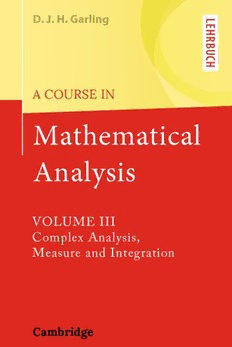Table Of ContentD. J. H. Garling
A COURSE IN
Mathematical
Analysis
VOLUME III
Complex Analysis,
Measure and Integration
Cambridge
A COURSE IN MATHEMATICAL ANALYSIS
Volume III: Complex Analysis, Measure and Integration
The three volumes of A Course in Mathematical Analysis provide a full
and detailed account of all those elements of real and complex analysis that
an undergraduate mathematics student can expect to encounter in the first
two or three years of study. Containing hundreds of exercises, examples
and applications, these books will become an invaluable resource for both
students and instructors.
VolumeIfocusesontheanalysisofreal-valuedfunctionsofarealvariable.
Volume II goes on to consider metric and topological spaces. This third
volume develops the classical theory of functions of a complex variable. It
carefully establishes the properties of the complex plane, including a proof
of the Jordan curve theorem. Lebesgue measure is introduced, and is used
as a model for other measure spaces, where the theory of integration is
developed. The Radon-Nikodym theorem is proved, and the differentiation
of measures is discussed.
d. j. h. garling is Emeritus Reader in Mathematical Analysis at the
University of Cambridge and Fellow of St. John’s College, Cambridge. He
has fifty years’ experience of teaching undergraduate students in most areas
of pure mathematics, but particularly in analysis.
A COURSE IN
MATHEMATICAL ANALYSIS
Volume III
Complex Analysis, Measure
and Integration
D. J. H. G A R L I N G
Emeritus Reader in Mathematical Analysis,
University of Cambridge, and
Fellow of St John’s College, Cambridge
TheEdinburghBuilding,CambridgeCB28RU,UK
PublishedintheUnitedStates ofAmericabyCambridgeUniversityPress,NewYork
CambridgeUniversityPressispartoftheUniversityofCambridge.
ItfurtherstheUniversity’smissionbydisseminatingknowledgeinthepursuitof
education, learningandresearchatthehighestinternational levelsofexcellence.
www.cambridge.org
Informationonthistitle:www.cambridge.org/9781107032040
(cid:2)c D.J.H.Garling2014
Thispublicationisincopyright.Subjecttostatutory exception
andtotheprovisionsofrelevantcollectivelicensingagreements,
noreproductionofanypartmaytakeplacewithoutthewritten
permissionofCambridgeUniversityPress.
Firstpublished2014
PrintedintheUnitedKingdombyCPIGroupLtd,CroydonCR04YY
A catalogue record for this publication is available from the British Library
Library of Congress Cataloguing inPublication Data
ISBN978-1-107-03204-0 Hardback
ISBN978-1-107-66330-5Paperback
CambridgeUniversityPresshasnoresponsibilityforthepersistenceoraccuracyof
URLsforexternal orthird-partyinternetwebsitesreferredtointhispublication,
anddoesnotguaranteethatanycontent onsuchwebsites is,orwillremain,
accurate orappropriate.
Contents
Volume III
Introduction page ix
Part Five Complex analysis 625
20 Holomorphic functions and analytic functions 627
20.1 Holomorphic functions 627
20.2 The Cauchy–Riemann equations 630
20.3 Analytic functions 635
20.4 The exponential, logarithmic and circular functions 641
20.5 Infinite products 645
20.6 The maximum modulus principle 646
21 The topology of the complex plane 650
21.1 Winding numbers 650
21.2 Homotopic closed paths 655
21.3 The Jordan curve theorem 661
21.4 Surrounding a compact connected set 667
21.5 Simply connected sets 670
22 Complex integration 674
22.1 Integration along a path 674
22.2 Approximating path integrals 680
22.3 Cauchy’s theorem 684
22.4 The Cauchy kernel 689
22.5 The winding number as an integral 690
22.6 Cauchy’s integral formula for circular and square paths 692
22.7 Simply connected domains 698
22.8 Liouville’s theorem 699
v
vi Contents
22.9 Cauchy’s theorem revisited 700
22.10 Cycles; Cauchy’s integral formula revisited 702
22.11 Functions defined inside a contour 704
22.12 The Schwarz reflection principle 705
23 Zeros and singularities 708
23.1 Zeros 708
23.2 Laurent series 710
23.3 Isolated singularities 713
23.4 Meromorphic functions and the complex sphere 718
23.5 The residue theorem 720
23.6 The principle of the argument 724
23.7 Locating zeros 730
24 The calculus of residues 733
24.1 Calculating residues (cid:2) 733
2π
24.2 Integrals of the form (cid:2) f(cost,sint)dt 734
0∞
24.3 Integrals of the form (cid:2)−∞f(x)dx 736
∞
24.4 Integrals of the form (cid:2) xαf(x)dx 742
0∞
24.5 Integrals of the form f(x)dx 745
0
25 Conformal transformations 749
25.1 Introduction 749
25.2 Univalent functions on C 750
∗
25.3 Univalent functions on the punctured plane C 750
25.4 The Mo¨bius group 751
25.5 The conformal automorphisms of D 758
25.6 Some more conformal transformations 759
25.7 The space H(U) of holomorphic functions on
a domain U 763
25.8 The Riemann mapping theorem 765
26 Applications 768
26.1 Jensen’s formula 768
26.2 The function πcotπz 770
26.3 The functions πcosecπz 772
26.4 Infinite products 775
26.5 *Euler’s product formula* 778
26.6 Weierstrass products 783
26.7 The gamma function revisited 790
26.8 Bernoulli numbers, and the evaluation of ζ(2k) 794
26.9 The Riemann zeta function revisited 797
Contents vii
Part Six Measure and Integration 801
27 Lebesgue measure on R 803
27.1 Introduction 803
27.2 The size of open sets, and of closed sets 804
27.3 Inner and outer measure 808
27.4 Lebesgue measurable sets 810
27.5 Lebesgue measure on R 812
27.6 A non-measurable set 814
28 Measurable spaces and measurable functions 817
28.1 Some collections of sets 817
28.2 Borel sets 820
28.3 Measurable real-valued functions 821
28.4 Measure spaces 825
28.5 Null sets and Borel sets 828
28.6 Almost sure convergence 830
29 Integration 834
29.1 Integrating non-negative functions 834
29.2 Integrable functions 839
29.3 Changing measures and changing variables 846
29.4 Convergence in measure 848
29.5 The spaces L1 (X,Σ,μ) and L1 (X,Σ,μ) 854
R C
29.6 The spaces Lp (X,Σ,μ) and Lp (X,Σ,μ), for 0 < p < ∞ 856
R C
∞ ∞
29.7 The spaces L (X,Σ,μ) and L (X,Σ,μ) 863
R C
30 Constructing measures 865
30.1 Outer measures 865
30.2 Caratheodory’s extension theorem 868
30.3 Uniqueness 871
30.4 Product measures 873
30.5 Borel measures on R, I 880
31 Signed measures and complex measures 884
31.1 Signed measures 884
31.2 Complex measures 889
31.3 Functions of bounded variation 891
32 Measures on metric spaces 896
32.1 Borel measures on metric spaces 896
32.2 Tight measures 898
32.3 Radon measures 900
viii Contents
33 Differentiation 903
33.1 The Lebesgue decomposition theorem 903
33.2 Sublinear mappings 906
33.3 The Lebesgue differentiation theorem 908
33.4 Borel measures on R, II 912
34 Applications 915
34.1 Bernstein polynomials 915
34.2 The dual space of Lp (X,Σ,μ), for 1 ≤ p < ∞ 918
C
34.3 Convolution 919
34.4 Fourier series revisited 924
34.5 The Poisson kernel 927
34.6 Boundary behaviour of harmonic functions 934
Index 936

